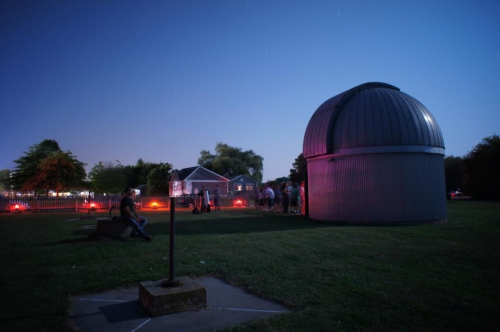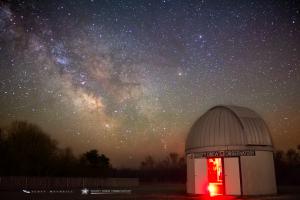
Stargazing Nights
- Where:
- Frosty Drew Observatory
- When:
- Friday April 14, 2017 at 8:00 p.m
- Cost:
- $1 Suggested Donation per Person
Tonight is Stargazing Night at Frosty Drew Observatory and forecasts are looking spectacular! We can expect clear skies for the entire night with light winds and moderate temps. The 86% waning gibbous Moon will rise just before 11:00 p.m. giving us a shot at super dark skies before moon rise. If that’s not awesome enough, add in that Jupiter will be visible for our entire viewing session with a shadow transit of Ganymede (Jupiter’s largest moon) visible for about 30 minutes after we open and the Great Red Spot coming into view around 11:00 p.m.
We will open the Observatory and Sky Theatre at 8:00 p.m. In the Observatory, telescopes will start out with a view of Jupiter, showcasing Ganymede’s shadow cast on Jupiter’s cloud tops. We call this a shadow transit, though if you were on Jupiter along the path of the shadow, you would call this a solar eclipse. As the night progresses, we will rock the night with views of galaxies, star clusters, and nebulae. Once the waning gibbous Moon rises, we will direct our telescopes towards the cratered lunar surface. The Sky Theatre will feature warm temps alongside our showcase of celestial objects photographed at Frosty Drew Observatory. We will stay open until midnight tonight celebrating the fabulous starscape.
Overall, tonight is the night to be out. We will have excellent viewing opportunities of Jupiter as well as super dark skies until the near-midnight moon rise. Being that the late rising Moon will be quite bright, Milky Way viewing during the morning hours will not be possible. Regardless, clear skies and no Moon until late will make for a fantastic night! So put the cosmos on your list of kick-starters for the holiday weekend, and celebrate a fabulous night under the stars.
------------------
Weekly Happenings
Scott MacNeill
On April 16 – 25, the annual Lyrid Meteor Shower blazes the sky bringing a slight increase in meteor activity. Though lasting a little over a week, the best night to be out is the peak night on April 21st, which is a Friday night. Overall the Lyrid shower is not all that spectacular, bringing only an additional 18 meteors per hour. What makes the Lyrids so great is that it’s the first of several notable meteor showers to occur since the early January Quadrantid shower, ending the nearly four month lull in meteor activity. Another perk of the Lyrid shower is the Milky Way. April is the month that the center of the Milky Way Galaxy returns to our nighttime skies, though you have to be out during the wee morning hours to catch a sight. Lyrid meteor watchers will be poised to catch spectacular views of the Milky Way during the morning hours of the shower. This year we will have a 19% waning gibbous Moon rising around 4:00 a.m. making for excellent viewing conditions of the Lyrids and the Milky Way. All we need now is clear skies. Set out around midnight Saturday morning to a location free of light pollution with a wide open view of the sky. Lay on your back with your feet to the NE and look to the zenith (top of the sky). The bright star, Vega, which is about 8° north of the shower’s radiant point, will rise around 9:00 p.m. on the 21st. Happy meteor watching!
Being that this past Tuesday morning was the Full Pink Moon (the April full Moon), which was the first full Moon since the Vernal Equinox, Easter will fall on this Sunday (April 16). Calculating the date of Easter every year is easy. It’s the first Sunday after the first Full Moon after the Vernal Equinox. This requirement is why we have such a large difference in dates that Easter falls on each year. Have a happy holiday weekend from all of us astro-geeks at Frosty Drew Observatory!
-Scott


